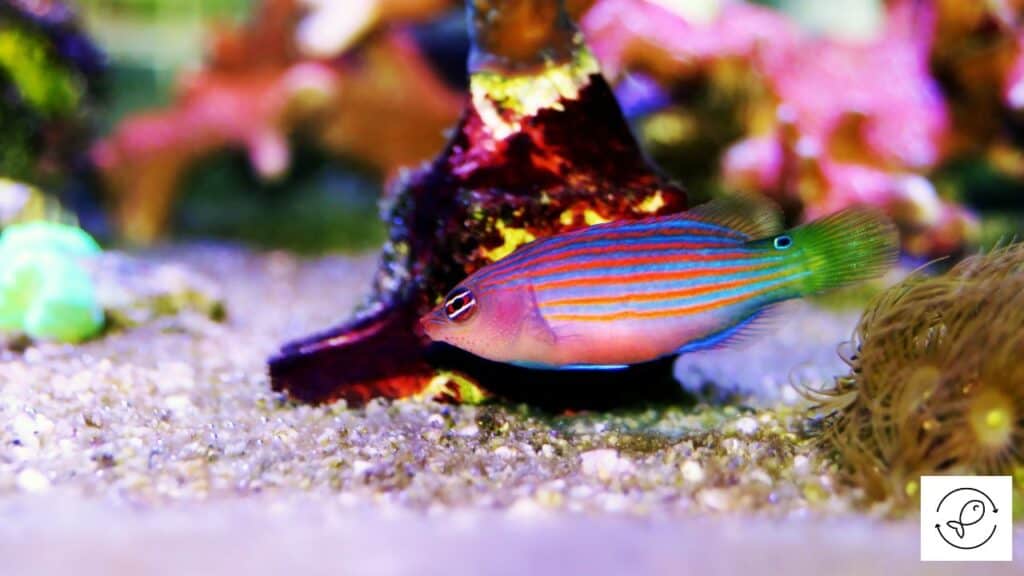Wrasses are one of the most stunning and vibrantly colored marine fish.
They’re also reef-safe and hence favorites among aquarists.
However, certain wrasse species have extensive dietary requirements and need thorough knowledge before owning them.
So let’s learn about wrasses in more detail.
Wrasse Species Overview
Wrasses are marine fish belonging to the Labridae family.
They primarily inhabit the tropical and subtropical waters of the Indian, Pacific, and Atlantic oceans.
Wrasses are usually found in shallow water habitats such as rocky shores, coral reefs, and tidal pools.
In the wild, they mainly bury themselves in the sandy substrate to prevent predation.
Wrasses are solitary fish and are usually found living alone in the wild. They’re rarely seen together in groups.
Appearance
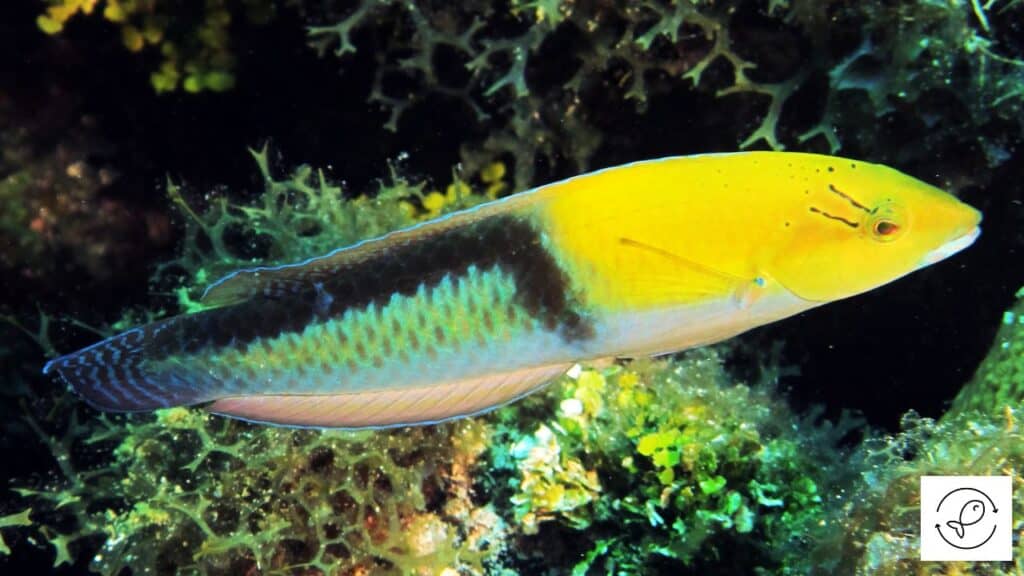
Wrasses are recognized by their pointed snout and prominent canine teeth.
They have an elongated body with long dorsal and anal fins.
Wrasses come in an array of patterns and markings depending on the species.
You can find wrasses in various colors like blue, green, red, orange, yellow, brown, and purple.
Male wrasses are usually more brightly colored than their female counterparts.
Males can also change their color and pattern while trying to impress females during mating.
You can distinguish their gender based on appearance.
For example, a female bluehead wrasse can be distinguished by her brown and yellow color against the male’s blue and green color.
Another interesting fact about wrasses is that they are dimorphic.
It means that many wrasse species can change their gender.
Young wrasses are a mix of males and females, also known as initial-phase individuals.
The largest fish develops into a territory-holding male, called the terminal-phase.
The largest and dominant female turns into a male when the largest male of the group is no more.
Names of Species
There are over 600 species of wrasses spread across 81 genera. They’re further divided into 9 sub-groups.
Each species is unique in color, shape, size, pattern, and personality.
So you have lots of options to choose from for your aquarium.
Some of the most popular wrasse species are:
- Humphead Wrasses,
- Blunthead Wrasses,
- Bluestreak Cleaner Wrasses,
- Lyretail Wrasses,
- Red Coris Wrasses,
- Splendid Pintail Fairy Wrasses,
- Hawaiian Cleaner Wrasses,
- Redfin Wrasses,
- Bicolor Cleaner Wrasses,
- Glorious Wrasses,
- Marshall Island Wrasses,
- Bluehead Wrasses,
- Banana Wrasses,
- Dragon Wrasses,
- Cortez Rainbow Wrasses,
- Timor Wrasses,
- Pink Margin Fairy Wrasses, etc.
Lifespan
The lifespan of wrasses depends on the species. Humphead wrasses can live up to 30 years.
In contrast, Fairy wrasses have a shorter lifespan of around 3 to 5 years.
The average lifespan of most wrasse species varies between 5 to 10 years.
Since most wrasses are hardy, providing a stress-free environment can increase their longevity in captivity.
Average Size
The size of the wrasses varies greatly depending on the species in the family.
Their size can range between 2 inches to 8 feet or more in length.
Humphead wrasse is the largest species that often grows up to 8 feet long.
On the other hand, Pink Margin Fairy wrasse is one of the smallest species that reach up to 2.5 inches.
Wrasse Tank Setup
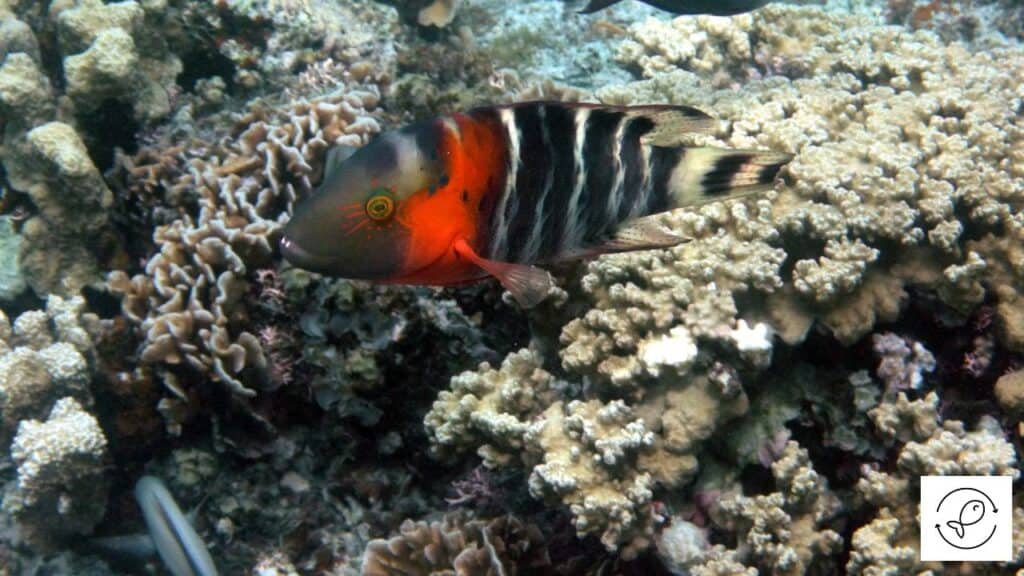
Wrasses don’t need a specialized tank setup.
However, they need a well-designed aquarium with all the essential equipment and plenty of space to swim and explore the surrounding.
Tank Size
Different species of wrasses need different sizes of aquariums.
Larger species like Humphead wrasses need a vast tank than smaller species.
A minimum of a 75-gallon tank is recommended for a single wrasse.
Even smaller wrasses need a big tank as they’re active and need ample space to explore.
Also, the tank setup determines the ideal tank size.
You need a larger tank if your aquarium has live rocks, plants, and other decorations.
It ensures that your fish isn’t cramped for space.
Tank Equipment and Decoration
Wrasses originate from the coral reefs with sand sea bottoms.
Hence, a sand substrate is best for them to replicate their natural environment.
Many wrasse species are reef-safe.
So you can set up a reef tank with corals and anemones to make them feel at home.
Hiding places are a must in a wrasse tank. Wrasses like to rest and hide in caves or rocks when tired.
Wrasses are known to jump out of the tank. Therefore, an aquarium hood or lid is necessary to prevent any accidents.
Finally, maintaining stable water parameters is vital for keeping wrasses healthy.
Hence, pH testing kits should be used regularly to monitor the water’s acidity and alkalinity levels.
Given below are the items required in a wrasse tank:
- Sand substrate,
- Filter,
- Heater,
- Aquatic plants,
- Aquarium lighting,
- Aquarium hood,
- Hiding places like caves, live rocks, driftwood, etc.
- Thermometer, and
- PH testing kit.
Wrasse Care
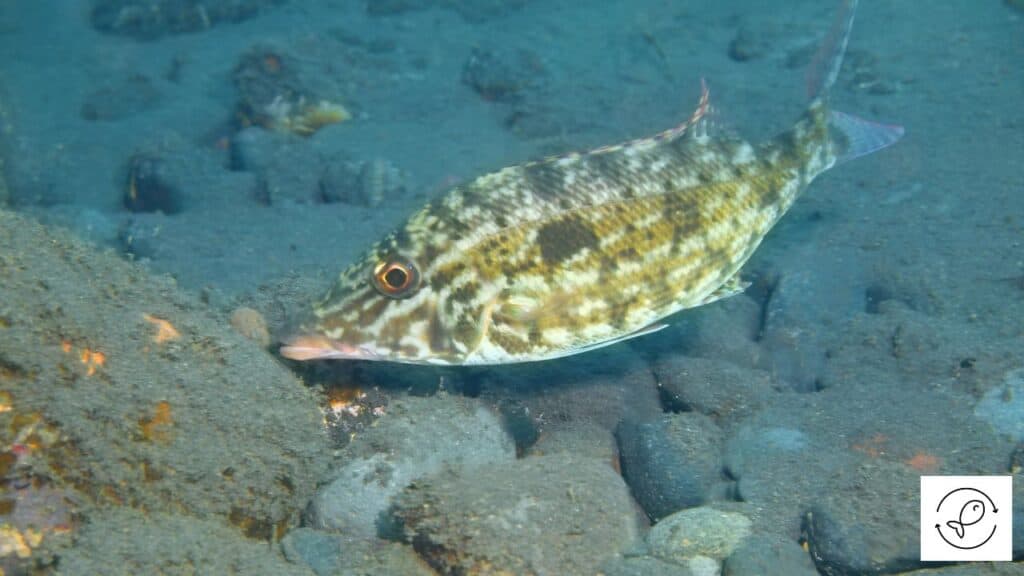
Most wrasse species are hardy and easy to care for.
However, some species like Leopard wrasses are more susceptible to stress and need special attention.
Hence, taking adequate care of wrasses is vital for their optimum growth.
Diet
Wrasses are carnivores that primarily feed on zooplankton in their natural environment.
In captivity, feeding them a varied and protein-rich diet can keep them healthy.
You can feed live or frozen food such as brine shrimp, mysis shrimp, grass shrimp, live blackworms, etc., to wrasses in captivity.
Feeding fish flakes or pellets can add variety to their diet.
Wrasses are also fond of mollusks, urchins, snails, crabs, copepods, and oyster eggs.
You can supplement their diet with vegetable flakes and seaweed. These foods contain fiber that helps in proper digestion.
Cleaner wrasses are challenging to feed as they must be fed in small quantities multiple times a day.
They can’t eat large portions of food at once as these wrasses have smaller stomachs and shorter digestive tracts.
Water Parameters
Wrasses are pretty hardy and can withstand some fluctuations in aquarium conditions.
Stable water chemistry that closely resembles their natural habitat is sufficient.
Being tropical fish, wrasses need warm and clean water to thrive.
The ideal water parameters for wrasses are:
Water Temperature: 72°F to 78°F (22°C to 26°C),
Water pH: 8.0 to 8.4,
Specific Gravity (Salinity): 1.020 to 1.025,
Water Hardness (dKH): 8 to 12.
Tank Maintenance
Reef species like wrasses need a well-maintained tank to thrive.
Periodic tank maintenance can help prevent ammonia build-up and maintain the health of your wrasse.
Regular cleaning of the substrate and gravel helps remove waste products and decaying organisms from the tank.
Cleaning the filter regularly will ensure that it remains free of debris and bacteria.
Similarly, the heater and other equipment must be checked periodically to ensure they work properly.
Water conditions must be monitored regularly with testing kits to maintain water parameters.
Common Diseases
Most wrasse species are popular for being hardy and aren’t prone to diseases.
However, certain wrasses are prone to stress and are more likely to catch infections.
Wrasses are known to nurse a host of viruses when you first purchase them.
Hence, it’s vital to quarantine the newly purchased wrasse for about a month before introducing it into the main tank.
It helps avoid transmission of any infection to the existing fish in the tank.
You can identify a healthy wrasse by its bright coloration and activity levels.
In contrast, symptoms such as cloudy eyes, faded coloration, lethargy, and rapid breathing may indicate illness.
Following are some of the common diseases that may affect wrasses:
- Bacterial infection,
- Parasitic infection,
- Fungal infection,
- Marine Ich,
- Marine velvet,
- White spots,
- Fin Rot, etc.
Wrasse Behavior and Temperament
Wrasses are mostly aggressive toward their own species.
However, they tolerate other fish and can coexist peacefully in a community aquarium.
Male wrasses are more territorial and don’t tolerate other male wrasses around them.
They tend to chase away intruders by biting and chasing them.
Hence, keeping multiple male wrasses in the same aquarium isn’t advisable.
Space shortage and food scarcity are the two main reasons for wrasses to exhibit aggression.
They’re very active and need ample space to swim freely in the tank.
A large aquarium with adequate food can help keep their aggression under control.
Wrasse Tankmates
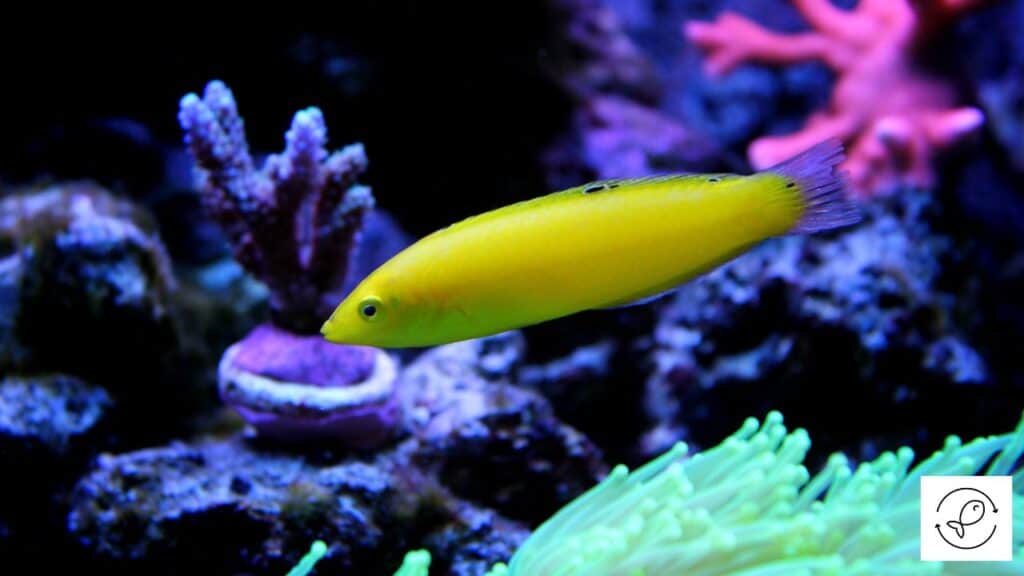
Wrasses can be aggressive toward other fish to show dominance.
Male wrasses are usually aggressive toward other male wrasses and can’t be housed in the same aquarium.
Hence, choosing appropriate tankmates that can withstand the aggressive and territorial behavior of wrasses is essential.
Given below are the ideal tankmates for wrasses:
- Clownfish,
- Saltwater angelfish,
- Gobies,
- Blennies,
- Rabbitfish,
- Butterflyfish,
- Tangs,
- Cardinal fish, etc.
Not all wrasse species are aggressive.
Some species like Fairy wrasses, Flasher wrasses, Leopard wrasses, and Four-Line wrasses can be housed together in the same aquarium.
Fish with similar colors or patterns shouldn’t be housed with wrasses to prevent aggression.
Similarly, large and predatory fish, as well as slow-moving and long-finned fish, should be avoided.
Peaceful fish also shouldn’t be housed with wrasses as they might get stressed due to constant bullying.
Some of the fish that you should avoid housing with wrasses are:
- Lionfish,
- Groupers,
- Saltwater triggerfish, and
- Puffers.
Wrasse Breeding
Breeding wrasses in captivity is incredibly difficult.
These fish are difficult to spawn in a home aquarium as they have a complicated mating process.
It means that the wrasses you find or purchase from pet stores or online are mostly wild-caught.
Hence, it’s best to let wrasses breed in their natural habitat, where their chances of survival are higher than in captivity.
In the wild, wrasses exhibit broadcast spawning.
This involves female wrasses releasing eggs into the water column where fertilization occurs externally.
The male wrasses then release their sperm into the water column to fertilize the eggs.
Broadcast spawning is common among many bony fish and wild sea creatures.

